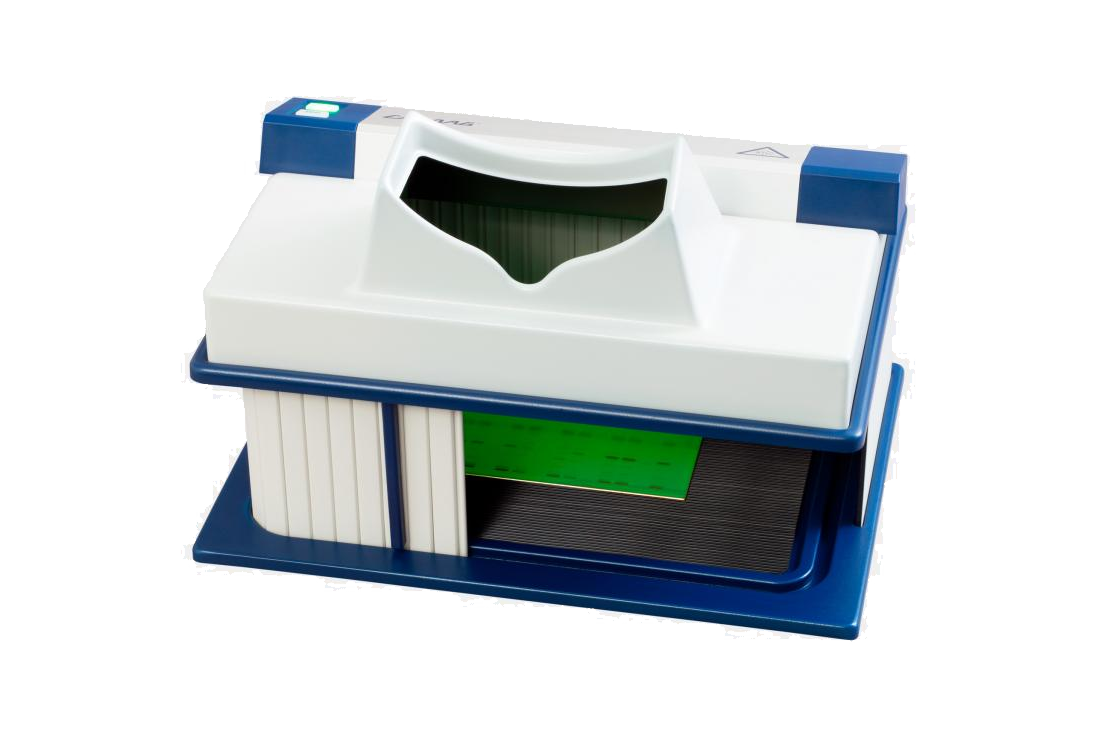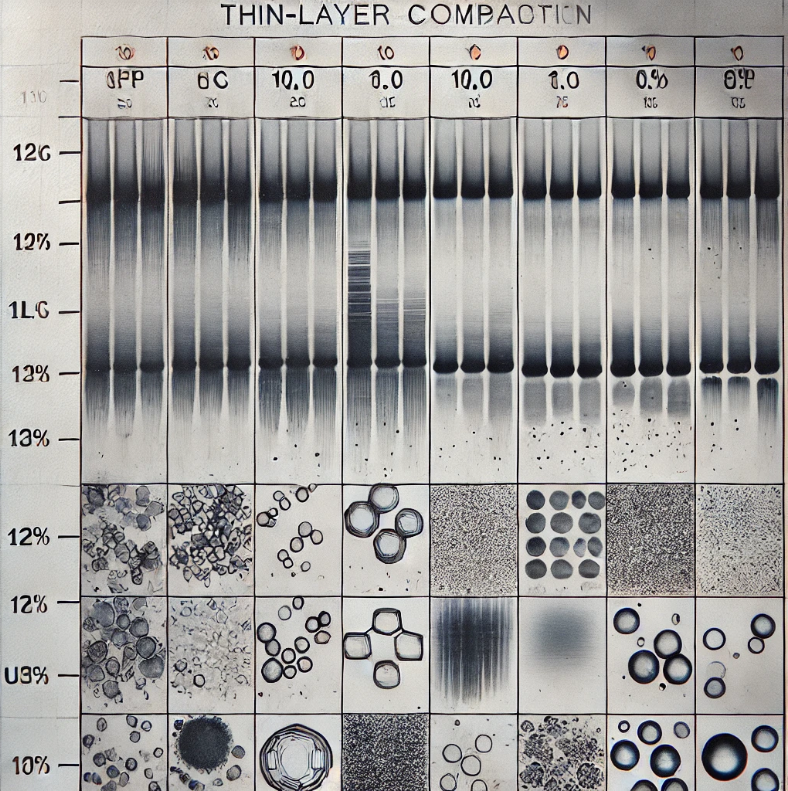Ultraviolet Ray Lamps for Analytical Purposes
Ultraviolet (UV) ray lamps are indispensable tools in analytical laboratories, serving a wide range of purposes, particularly in chromatographic methods such as thin-layer chromatography (TLC) and high-performance thin-layer chromatography (HPTLC). These lamps provide UV light at specific wavelengths, typically 254 nm and 365 nm, allowing compounds that are UV-active to be detected either through fluorescence or absorption. The precision and reliability of UV ray lamps make them crucial for qualitative and quantitative analyses in various fields, including pharmaceuticals, environmental testing, and food and cosmetic quality control.
chromatography (TLC) and high-performance thin-layer chromatography (HPTLC). These lamps provide UV light at specific wavelengths, typically 254 nm and 365 nm, allowing compounds that are UV-active to be detected either through fluorescence or absorption. The precision and reliability of UV ray lamps make them crucial for qualitative and quantitative analyses in various fields, including pharmaceuticals, environmental testing, and food and cosmetic quality control.
Chemical Methods of Detection
Chemical detection methods in TLC and HPTLC rely heavily on the interaction between UV light and the chemical compounds on a chromatographic plate. UV lamps provide two primary types of detection: fluorescence detection at 365 nm (long-wave UV) and absorbance detection at 254 nm (short-wave UV). These methods allow analysts to visualize compounds that are otherwise invisible to the naked eye, enhancing the analytical power of chromatographic techniques.
- Fluorescence Detection: Fluorescence detection under UV light at 365 nm is ideal for compounds that fluoresce when excited by this wavelength. The UV light excites the molecules, causing them to emit visible light, which can be detected and analyzed. This method is particularly effective for organic compounds with conjugated systems or specific functional groups that allow fluorescence. In TLC, fluorescent spots appear brightly against a dark background, facilitating clear visualization. To further enhance detection, compounds that do not naturally fluoresce can be treated with specific reagents that render them fluorescent under UV light.
- Absorbance Detection: At 254 nm, UV lamps enable absorbance detection, where compounds that absorb UV light appear as dark spots against the illuminated background. This wavelength is especially effective for compounds with aromatic rings or multiple conjugated double bonds, as these structural features readily absorb UV light. In pharmaceuticals, this method is frequently used to detect active ingredients in drug formulations, providing both qualitative and quantitative data. By using absorbance detection, analysts can identify and quantify compounds in complex mixtures with a high degree of specificity.
Reagent-Based Detection Techniques
In addition to fluorescence and absorbance detection, reagent-based detection is a vital technique in UV detection methods. This involves applying reagents to the chromatographic plate that react with specific compounds to produce visible colors or enhanced fluorescence under UV light. For example, spraying TLC plates with fluorescein or rhodamine enhances the visualization of compounds under 365 nm UV light. These reagents are particularly useful when working with compounds that do not naturally absorb or fluoresce under UV light, expanding the range of detectable substances. This technique is often used in HPTLC, where multiple reagents can be applied sequentially to target different functional groups, improving specificity and versatility in detection.
chromatographic plate that react with specific compounds to produce visible colors or enhanced fluorescence under UV light. For example, spraying TLC plates with fluorescein or rhodamine enhances the visualization of compounds under 365 nm UV light. These reagents are particularly useful when working with compounds that do not naturally absorb or fluoresce under UV light, expanding the range of detectable substances. This technique is often used in HPTLC, where multiple reagents can be applied sequentially to target different functional groups, improving specificity and versatility in detection.
Documentation and Hints for Chromatography Experts
Accurate documentation is essential in chromatographic analysis to ensure the reproducibility and reliability of results. Proper documentation covers all aspects of the chromatographic process, from sample preparation to post-analysis, allowing researchers to track and replicate experiments accurately. Below are key considerations for effective documentation in UV-based chromatographic analyses.
Preparations for Chromatography
Preparations for chromatography involve careful selection of the mobile and stationary phases, sample preparation, and adjustments for solvent purity. Analysts must choose solvents that are free from contaminants that might interfere with UV detection. For instance, ethanol used in sodium salicylate preparation must be non-fluorescent to avoid interference. Additionally, the choice of adsorbent, such as silica gel or alumina, should be documented, as variations in adsorbent properties can affect compound migration on the plate. Pre-washing the chromatographic layer is often recommended to remove impurities, ensuring high-quality results when the UV lamp is applied.
Solvent Quality and Selection of Stationary Phases
Selecting high-purity solvents is critical in chromatographic analyses. Contaminants in solvents can produce background fluorescence or affect the absorbance readings, leading to inaccurate results. For instance, the European Pharmacopoeia specifies that ethanol used in the sodium salicylate test must be free from fluorescence, ensuring that only the compounds of interest are visible under UV light. Likewise, the choice of stationary phase affects the separation efficiency and detection sensitivity. Different types of silica gels or modified surfaces are used based on the chemical properties of the analytes, as the interaction between the stationary phase and the compounds directly influences their migration and visibility under UV light.
Fixing and Documenting the Chromatogram Appearance
Once developed, chromatograms can be fixed and documented for future reference. Fixing agents may be applied to stabilize the visualization, ensuring that fluorescent or colorimetric responses are preserved. This is especially useful when chromatograms need to be archived or shared. Digital documentation, including photographing or scanning under UV light, provides a permanent record of the results, allowing for detailed analysis and comparison across experiments. In modern laboratories, digital in situ evaluation, where chromatograms are immediately scanned and analyzed by software, minimizes human error and provides quantitative data that are critical in analytical quality control.
In Situ Evaluation and Digital Documentation
Advancements in digital technology have enabled in situ evaluation and real-time documentation of chromatograms. Specialized software can analyze the chromatogram under UV light, capturing fluorescence or absorbance data with high precision. This method provides quantitative analysis that is more accurate than traditional visual inspection. Moreover, digital documentation allows for easy storage and retrieval, facilitating collaboration and review in multi-site projects or over extended timeframes.
The European Pharmacopoeia outlines specific testing requirements to ensure that UV lamps used in analytical settings meet performance standards. A standardized test involves using sodium salicylate as a reference compound. A solution of sodium salicylate is applied to a TLC plate, and the plate is examined under the UV lamp at 254 nm or 365 nm, depending on the lamp’s output. The test checks the lamp's ability to produce a clear, visible spot or band, confirming its suitability for detecting compounds on chromatographic plates. This performance test ensures that the UV lamp provides consistent and sufficient illumination, which is essential for reproducible and accurate analyses.
Sodium Salicylate Performance Test
The sodium salicylate performance test is conducted by applying a 0.4 g/L solution of sodium salicylate in ethanol for 254 nm lamps and a 2 g/L solution for 365 nm lamps. The UV lamp should clearly reveal a standard spot of sodium salicylate about 5 mm in diameter on a TLC plate. This test verifies the UV lamp's effectiveness in revealing compounds, ensuring reliable results in pharmacopoeial tests and other analytical applications.
Distance and Alignment Requirements
The distance between the UV lamp and the chromatographic plate during analytical procedures should not exceed the distance used in the sodium salicylate performance test. This ensures that the intensity of UV light during testing matches the conditions under which the lamp’s performance was validated, providing consistency in illumination and detection across different tests.
Applications of UV Lamps in Analytical Chemistry
UV lamps are widely used in various fields of analytical chemistry, offering selective and sensitive detection methods for both qualitative and quantitative analyses.
- Pharmaceuticals: UV lamps are essential in pharmaceutical quality control, where they are used to detect impurities, confirm compound identity, and assess the purity of active ingredients. The selective absorption and fluorescence properties of drugs and their impurities can be visualized under UV light, allowing for precise monitoring of pharmaceutical formulations.
- Environmental Testing: Environmental samples often contain trace pollutants that can be detected under UV light. UV lamps enable the detection of fluorescent or UV-absorbing contaminants, such as polycyclic aromatic hydrocarbons, which are common in water and soil samples. By using TLC in combination with UV detection, environmental scientists can assess pollution levels and identify specific pollutants.
- Food and Cosmetics: UV lamps play a crucial role in ensuring the safety and quality of food and cosmetic products. Additives, preservatives, and contaminants in these products can be detected through fluorescence or absorbance under UV light. Regulatory bodies often require such testing to ensure compliance with safety standards.
References
- European Pharmacopoeia. Ultraviolet Ray Lamps for Analytical Purposes.
- Jork, H., Funk, W., Fischer, W., & Wimmer, H. Thin-Layer Chromatography, Volume 1a & 1b.
 chromatography (TLC) and high-performance thin-layer chromatography (HPTLC). These lamps provide UV light at specific wavelengths, typically 254 nm and 365 nm, allowing compounds that are UV-active to be detected either through fluorescence or absorption. The precision and reliability of UV ray lamps make them crucial for qualitative and quantitative analyses in various fields, including pharmaceuticals, environmental testing, and food and cosmetic quality control.
chromatography (TLC) and high-performance thin-layer chromatography (HPTLC). These lamps provide UV light at specific wavelengths, typically 254 nm and 365 nm, allowing compounds that are UV-active to be detected either through fluorescence or absorption. The precision and reliability of UV ray lamps make them crucial for qualitative and quantitative analyses in various fields, including pharmaceuticals, environmental testing, and food and cosmetic quality control. chromatographic plate that react with specific compounds to produce visible colors or enhanced fluorescence under UV light. For example, spraying TLC plates with fluorescein or rhodamine enhances the visualization of compounds under 365 nm UV light. These reagents are particularly useful when working with compounds that do not naturally absorb or fluoresce under UV light, expanding the range of detectable substances. This technique is often used in HPTLC, where multiple reagents can be applied sequentially to target different functional groups, improving specificity and versatility in detection.
chromatographic plate that react with specific compounds to produce visible colors or enhanced fluorescence under UV light. For example, spraying TLC plates with fluorescein or rhodamine enhances the visualization of compounds under 365 nm UV light. These reagents are particularly useful when working with compounds that do not naturally absorb or fluoresce under UV light, expanding the range of detectable substances. This technique is often used in HPTLC, where multiple reagents can be applied sequentially to target different functional groups, improving specificity and versatility in detection.